

How big data and The Sims are helping us to build the cities of the future. By 2050, the United Nations predicts that around 66% of the world’s population will be living in urban areas.
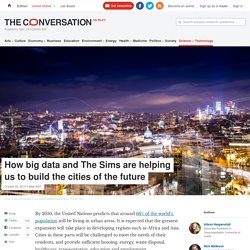
It is expected that the greatest expansion will take place in developing regions such as Africa and Asia. Cities in these parts will be challenged to meet the needs of their residents, and provide sufficient housing, energy, waste disposal, healthcare, transportation, education and employment. So, understanding how cities will grow – and how we can make them smarter and more sustainable along the way – is a high priority among researchers and governments the world over. We need to get to grips with the inner mechanisms of cities, if we’re to engineer them for the future. Fortunately, there are tools to help us do this. A whole new (simulated) world Cities are complex systems. Complex organisms are characterised by individual units that can be driven by a small number of simple rules.
Similarly, ant colonies can exhibit very sophisticated and seemingly intelligent behaviour. Smart cities of the future. Abstract Here we sketch the rudiments of what constitutes a smart city which we define as a city in which ICT is merged with traditional infrastructures, coordinated and integrated using new digital technologies.
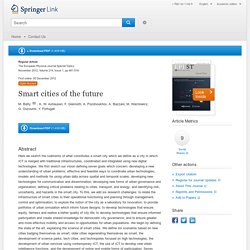
Smart cities : où sont-elles en Europe ? Les Etats membres de l'Union européenne comptent pas moins de 240 villes intelligentes. 18 d'entre elles se situent en France. 94 381 454, c'est le nombre de personnes qui coulent des jours heureux dans l'une des 240 villes de plus de 100 000 habitants dites "intelligentes" que comptent les 28 Etats membres de l'Union européenne.
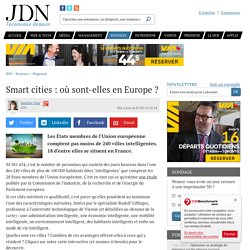
C'est en tout cas ce qu'estime une étude publiée par la Commission de l'industrie, de la recherche et de l'énergie du Parlement européen. Si ces cités méritent ce qualificatif, c'est parce qu'elles possèdent au minimum l'une des caractéristiques suivantes, listées par le spécialiste Rudolf Giffinger, professeur à l'université technologique de Vienne (et détaillées au-dessous de la carte) : une administration intelligente, une économie intelligente, une mobilité intelligente, un environnement intelligent, des habitants intelligents et enfin un mode de vie intelligent. Quelles sont ces villes ? Combien de ces avantages offrent-elles à ceux qui y résident ? The 3 Generations Of Smart Cities. Smart cities are getting more and more attention in the media, from technology companies and entrepreneurs, and increasingly from both local governments and civil society.
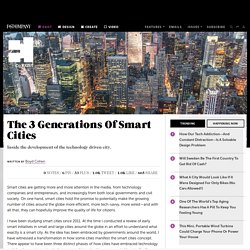
On one hand, smart cities hold the promise to potentially make the growing number of cities around the globe more efficient, more tech-savvy, more wired—and with all that, they can hopefully improve the quality of life for citizens. I have been studying smart cities since 2011. At the time I conducted a review of early smart initiatives in small and large cities around the globe in an effort to understand what exactly is a smart city.
As the idea has been embraced by governments around the world, I have witnessed a transformation in how some cities manifest the smart cities concept. Dystopian city and urban policy: City planners should read more sci-fi. Photo by Johannes Eisele/AFP/Getty Images This piece is part of Future Tense, a partnership of Slate, New America, and Arizona State University.

On Thursday, Oct. 2, Future Tense will host an event in Washington, D.C., on science fiction and public policy, inspired by the new anthology Hieroglyph: Stories & Visions for a Better Future. For more information on the event and to RSVP, visit the New America website; for more on Hieroglyph, visit the website of ASU’s Project Hieroglyph. Perhaps because cities are hotbeds of social and technological innovation, they often have starring roles in futuristic stories. But these aren’t generally tales of a better tomorrow. One of the first cinematic masterworks in the genre, 1927’s Metropolis, is about the horrors of the modern, industrial city. Jacobs and other neighborhood activists advocated for cities that welcomed pedestrians with a mix of commercial and residential uses in each neighborhood. Vf_rapport_jutand. The Director of the MIT SENSEable City Laboratory on Why the Smart City Isn't Enough. The Smart City isn’t enough.
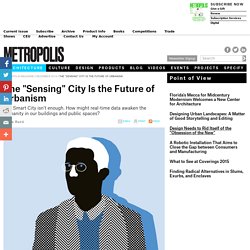
How might real-time data awaken the humanity in our buildings and public spaces? Carlo Ratti Illustration by Sara Andreasson The interface between humans and their environments—the very definition of architecture—is rapidly changing. Advances in digital, communication, and even biological technologies aren’t just transforming the way we interact with each other—they are also fundamentally shaping how we experience the city around us. For us at the SENSEable City Laboratory, the Smart City presents an incomplete picture.
This is an old dream of architecture that goes all the way back to Michelangelo, who, it’s said, struck his finished sculpture of Moses with a chisel, shouting, “Perché non parli?” This dialogue reaches far beyond Siri, as Paola Antonelli demonstrated with her exhibition at the MoMA, Talk to Me, in 2011. At the lab, and at my design practice, we try to express this systemic thinking in our design work. Edit ModuleEdit Module.